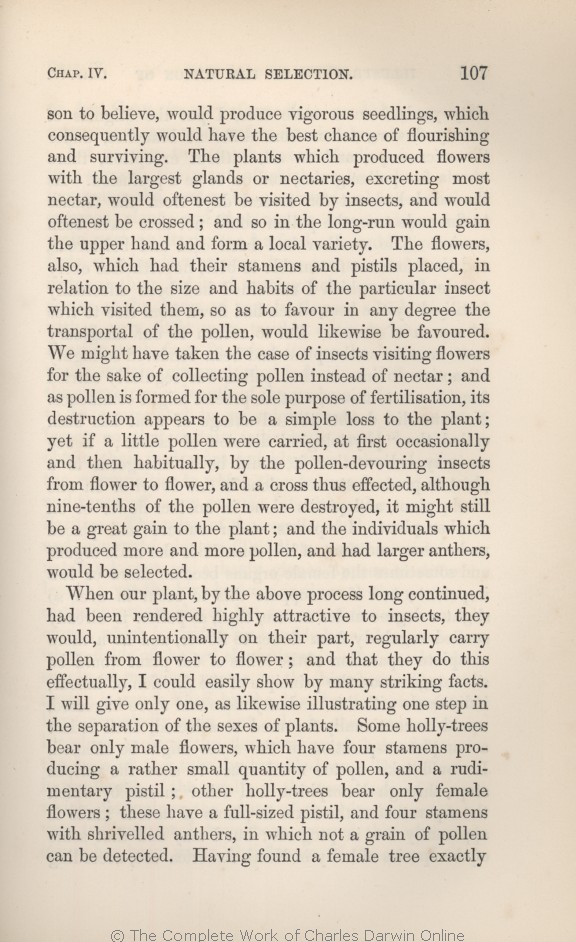vigorous seedlings, which consequently would have the best chance of flourishing and surviving. The plants which produced flowers with the largest glands or nectaries, excreting most nectar, would oftenest be visited by insects, and would oftenest be crossed; and so in the long-run would gain the upper hand and form a local variety. ↑| 2 blocks not present in 1869 1872; present in 1859 1860 1861 1866 | | Some of these seedlings would probably
inherit the nectar-excreting power.
Those individual flowers which had the largest glands or nectaries, and which excreted most nectar, would be oftenest visited by insects, and would be oftenest crossed; and so in the long-run would gain the upper hand.
|
| The 1869 1872 | | Those 1859 1860 1861 1866 |
| insect 1869 1872 | | insects 1859 1860 1861 | | insects, 1866 |
| the 1869 1872 | | their 1859 1860 1861 1866 |
| pollen, 1869 1872 | | pollen 1859 1860 1861 1866 |
| OMIT 1869 1872 |
| from flower to flower, 1859 1860 1861 1866 |
| favoured. 1869 1872 | | favoured 1859 1860 1861 1866 |
| ..... 1869 1872 | | or 1859 1860 1861 1866 |
| ..... 1869 1872 | | selected. 1859 1860 1861 1866 |
| purpose 1869 1872 | | object 1859 1860 1861 1866 |
| to be a 1869 1872 |
| a 1859 1860 1861 1866 |
| plant; 1859 1860 1861 1866 1869 | | plant 1872 |
| and the 1869 |
| and those 1859 1860 1861 1866 |
| to be thus robbed; and the 1872 |
| ..... 1869 1872 | | and larger 1859 1860 1861 1866 |
|
|
When our plant, by
the above process long continued, | the above process long continued, 1869 1872 |
| this process of the continued preservation or natural selection of more and more attractive flowers, 1859 1860 1861 1866 |
| OMIT 1869 1872 |
| can most effectually 1859 1860 1861 |
| can effectually 1866 |
| this 1869 1872 | | this, 1859 1860 1861 1866 |
| effectually, I 1869 1872 | | I 1859 1860 1861 1866 |
| facts. 1869 1872 | | instances. 1859 1860 1861 1866 |
| one, 1869 1872 |
| one— not as a very striking case, but 1859 1860 1861 1866 |
| plants. 1869 1872 | | plants, 1859 1860 1861 1866 |
| ..... 1869 1872 | | presently 1859 1860 1861 1866 |
| ..... 1869 1872 | | to 1859 1860 1861 1866 |
| ..... 1869 1872 | | be 1859 1860 1861 1866 |
| ..... 1869 1872 | | alluded 1859 1860 1861 1866 |
| ..... 1869 1872 | | to. 1859 1860 1861 1866 |
| a rather 1860 1861 1866 1869 1872 | | rather a 1859 |
| holly-trees 1859 1860 1861 1866 1869 | | holly trees 1872 |
|









